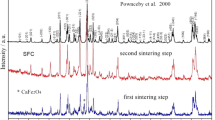Abstract
In this study, the effect of change in electric and magnetic characteristics of Al–Cu–Fe quasicrystals (QCs), by de-alloying of Al from the surface, was investigated. Dissolution of Al was carried out in NaOH aqueous solution which did not change the icosahedral structure of Al–Cu–Fe; however, it changed the non-magnetic nature of Al–Cu–Fe QCs into the ferromagnetic one. This has never been reported in previous studies on Al–Cu–Fe QCs. The ferromagnetic characteristics of icosahedral Al–Cu–Fe QCs powder (at room temperature and 5 K) were studied in detail using vibrating sample magnetometer (VSM). For the first time, it is reported that the value of susceptibility (χm) of Al–Cu–Fe QCs was in the order of 103 which is considerably greater then χm value of diamagnetic and paramagnetic materials. The VSM data indicate that approximately ≈ 1.5% of the total Fe atoms in icosahedral Al–Cu–Fe QC contribute to magnetism and most of which comes from the leached icosahedral surface. Further, Mössbauer spectroscopy (MS) results of Al–Cu–Fe QC powder samples confirm the presence of high spin Fe3+ ionic state. Linear lines of current–voltage (I–V) graph indicate the Ohmic behavior of samples before and after leaching process.












Similar content being viewed by others
References
M. Sreekala, M. Kumaran, S. Thomas, Oil palm fibers: Morphology, chemical composition, surface modification, and mechanical properties. J. Appl. Polym. Sci. 66(5), 821–835 (1997)
N. Sgriccia, M. Hawley, M. Misra, Characterization of natural fiber surfaces and natural fiber composites. Compos. A Appl. Sci. Manuf. 39(10), 1632–1637 (2008)
S.K. Sundaram, S. Jayabal, Regression modeling and particle swarm optimization of mechanical properties of potassium hydroxide pretreated Dharbai fiber-reinforced polyester composites. Proc. Inst. Mech. Eng. Part L J. Mater. Des. Appl. 230(1), 105–115 (2016)
I.O. Oladele, J.A. Omotoyinbo, B.O. Adewuyi, Mechanical and water absorption properties of sisal-fibre-reinforced polypropylene composites for ceiling applications. West Indian J. Eng. 37(1), 29–35 (2014)
D. Bikiaris et al., Use of silane agents and poly (propylene-g-maleic anhydride) copolymer as adhesion promoters in glass fiber/polypropylene composites. J. Appl. Polym. Sci. 81(3), 701–709 (2001)
N.R. Paluvai, S. Mohanty, S. Nayak, Unsaturated polyester-toughened epoxy composites: Effect of sisal fiber on thermal and dynamic mechanical properties. J. Vinyl Add. Tech. 23(3), 188–199 (2017)
I.M. De Rosa et al., Morphological, thermal and mechanical characterization of okra (Abelmoschus esculentus) fibres as potential reinforcement in polymer composites. Compos. Sci. Technol. 70(1), 116–122 (2010)
X. Lu et al., The preparation of self-reinforced sisal fiber composites. Polym. Polym. Compos. 12(4), 297–308 (2004)
P.J. Launer, Infrared analysis of organosilicon compounds: spectra-structure correlations, in Silicone Compd. Reg. Rev. 100 (1987)
T. An-Pang, I. Akihisa, M. Tsuyoshi, A stable quasicrystal in Al–Cu–Fe system. Jpn. J. Appl. Phys. 26(9A), L1505 (1987)
A.I. Goldman, Icosahedral glass models for quasicrystals, in Bond-Orientational Order in Condensed Matter Systems, K.J. Strandburg, Editor, Springer, New York, pp. 341–380 (1992)
T. Tanabe, S. Kameoka, A.P. Tsai, Microstructure of leached Al–Cu–Fe quasicrystal with high catalytic performance for steam reforming of methanol. Appl. Catal. A 384(1–2), 241–251 (2010)
A. Zahoor et al., Antimicrobial behavior of leached Al–Cu–Fe-based quasicrystals. Appl. Phys. A 126, 1–9 (2020)
K. Fukamichi, Magnetic properties of quasicrystals, in Physical Properties of Quasicrystals. (Springer, 1999), pp. 295–326
A.I. Goldman, Magnetism in icosahedral quasicrystals: current status and open questions. Sci. Technol. Adv. Mater. 15(4), 044801 (2014)
J. Dolinšek et al., Intrinsic electrical, magnetic, and thermal properties of single-crystalline Al 64 Cu 23 Fe 13 icosahedral quasicrystal: Experiment and modeling. Phys. Rev. B 76(5), 054201 (2007)
V.C. Srivastava et al., Synthesis of single phase i-AlCuFe bulk quasicrystal by spray forming. Z. Kristallogr. Int. J. Struct. Phys. Chem. Asp. Cryst. Mater. 223(11–12), 711–715 (2008)
T.S. Mishra, S. Pandey, Leaching of Al-based polygrain quasicrystalline and related crystalline surfaces (2014)
V. Srivastava et al., Bulk synthesis by spray forming of Al–Cu–Fe and Al–Cu–Fe–Sn alloys containing a quasicrystalline phase. J. Alloy. Compd. 597, 258–268 (2014)
F. Ali, Mechanical Milling of Al–Cu–Fe quasicrystals and their reinforcement in aluminum matrix composites, Verlag nicht ermittelbar (2012)
P. Horowitz, H. Winfield, in The Art of Electronics, 2nd edn, Cambridge Univ. Press (1989)
H. Wahab, Effect of coordination environment on the localization behavior and band tail states of Zn0.7In0.3Fe2O4 and Zn0.3In0.7Fe2O4 nanoparticles. J. Mater. Sci. Mater. Electron. 31(21), 18954–18963 (2020)
F. Bødker et al., Magnetic properties of hematite nanoparticles. Phys. Rev. B 61(10), 6826 (2000)
M. Pillaca Quispe, et al., Influence of high energy milling on the microstructure and magnetic properties of the Al–Cu–Fe phases: the case of the i-Al64Cu23Fe13 quasicrystalline and the ω-Al70Cu20Fe10 crystalline phases. RSC Adv. (2016)
Author information
Authors and Affiliations
Corresponding author
Additional information
Publisher's Note
Springer Nature remains neutral with regard to jurisdictional claims in published maps and institutional affiliations.
Rights and permissions
About this article
Cite this article
Zahoor, A., Shahid, R.N., Tariq, NuH. et al. Effect on electrical and magnetic behavior of Al–Cu–Fe quasicrystals during surface leaching. Appl. Phys. A 127, 551 (2021). https://doi.org/10.1007/s00339-021-04695-3
Received:
Accepted:
Published:
DOI: https://doi.org/10.1007/s00339-021-04695-3




